Network DEA and Its Applications (2017–2022): A Systematic Literature Review
Abstract
1. Introduction
2. Materials and Methods
- We selected only articles published in peer-reviewed journals.
- Articles were written in English.
- We did not take into account references that could not be found or accessed (broken links or journal’s website no longer being online).
- We did not consider retracted articles and article updates: correction, erratum, etc.
- We did not select articles that are currently in press.
- We chose only articles devoted to multi-stage and network DEA models.
3. Results
3.1. Statistics on NDEA Publications
| No. | Publisher | Articles | Percent |
|---|---|---|---|
| 1 | Elsevier BV | 176 | 29.43% |
| 2 | Springer Science and Business Media LLC | 81 | 13.55% |
| 3 | MDPI AG | 72 | 12.04% |
| 4 | Informa UK Limited | 45 | 7.53% |
| 5 | AZADTABRIZ—Islamic Azad University | 24 | 4.01% |
| 6 | Emerald | 22 | 3.68% |
| 7 | Hindawi Limited | 19 | 3.18% |
| 8 | Wiley | 17 | 2.84% |
| 9 | Inderscience Publishers | 12 | 2.01% |
| 10 | EDP Sciences | 10 | 1.67% |
| 11 | IOS Press | 6 | 1.00% |
| 12 | Sinaweb as Publisher | 6 | 1.00% |
| 13 | Public Library of Science (PLoS) | 5 | 0.84% |
| 14 | American Institute of Mathematical Sciences (AIMS) | 5 | 0.84% |
| Total | 500 | 83.61% |
- NDEA methodology (red), 265 publications;
- Eco-efficiency (green), 215 publications;
- Reviews (blue), 183 publications;
- Selection criteria (yellow), 171 publications;
- Banking industry (purple), 83 publications;
- Science (turquoise), 81 publications;
- Life cycle assessment (orange), 60 publications;
- R&D (beige), 41 publications;
- Technological production (lilac), 25 publications;
- Ecology and nature (gray), 17 publications;
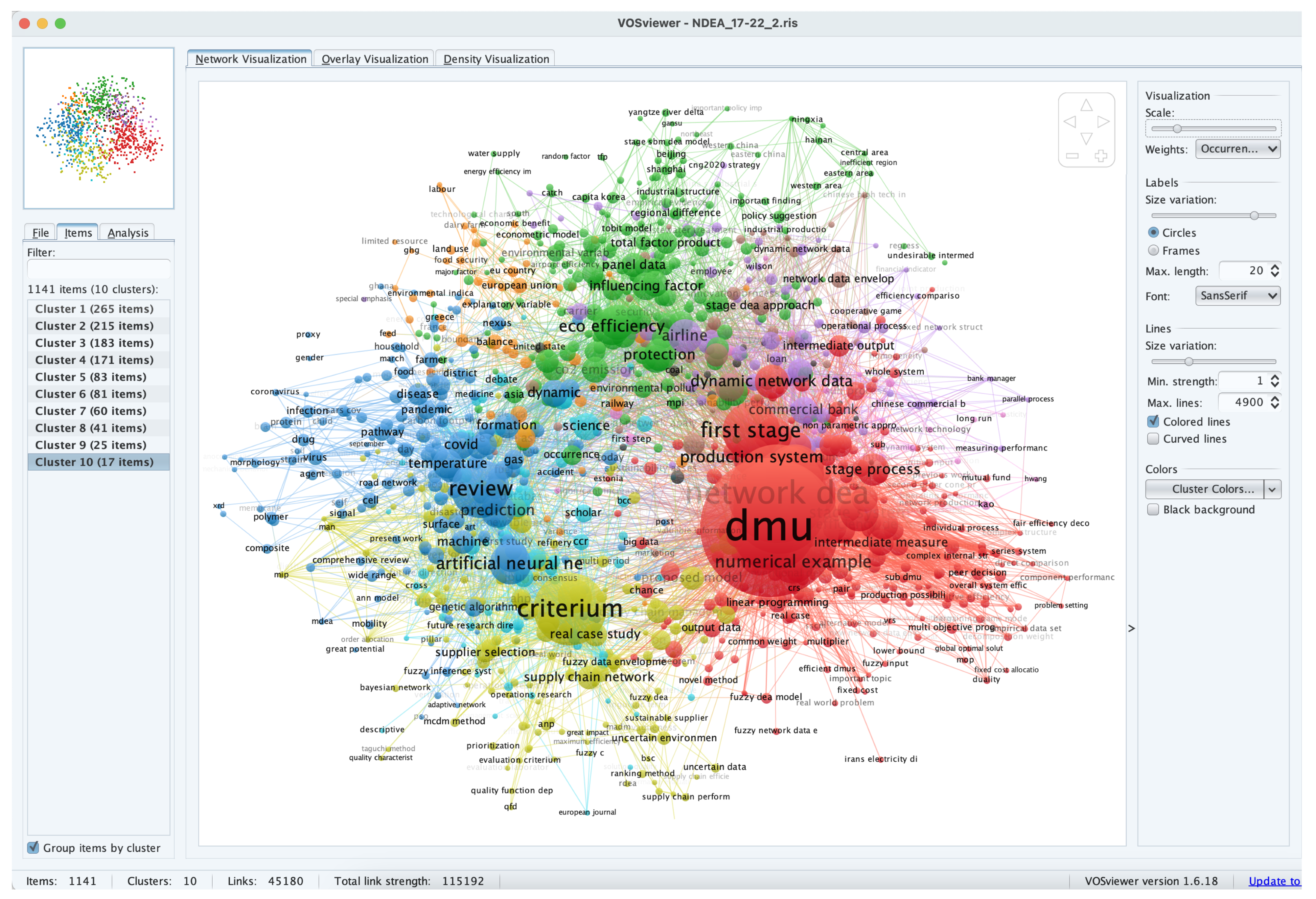
3.2. Practical Applications of NDEA
4. Conclusions
Author Contributions
Funding
Data Availability Statement
Conflicts of Interest
References
- Charnes, A.; Cooper, W.W.; Rhodes, E. Measuring the efficiency of decision making units. Eur. J. Oper. Res. 1978, 2, 429–444. [Google Scholar] [CrossRef]
- Cooper, W.W.; Seiford, L.M.; Tone, K. Data Envelopment Analysis. A Comprehensive Text with Models, Applications, References and DEA-Solver Software, 2nd ed.; Springer: New York, NY, USA, 2007. [Google Scholar] [CrossRef]
- Tone, K. A slacks-based measure of efficiency in data envelopment analysis. Eur. J. Oper. Res. 2001, 130, 498–509. [Google Scholar] [CrossRef]
- Lovell, C.A.K.; Walters, L.C.; Wood, L.L. Stratified Models of Education Production Using Modified DEA and Regression Analysis. In Data Envelopment Analysis: Theory, Methodology, and Applications; Springer: Dordrecht, The Netherlands, 1994; pp. 329–351. [Google Scholar] [CrossRef]
- Wang, C.H.; Gopal, R.D.; Zionts, S. Use of Data Envelopment Analysis in assessing Information Technology impact on firm performance. Ann. Oper. Res. 1997, 73, 191–213. [Google Scholar] [CrossRef]
- Kao, C. Efficiency measurement for hierarchical network systems. Omega 2015, 51, 121–127. [Google Scholar] [CrossRef]
- Tone, K.; Tsutsui, M. Dynamic DEA with network structure: A slacks-based measure approach. Omega 2014, 42, 124–131. [Google Scholar] [CrossRef]
- Kao, C. Network data envelopment analysis: A review. Eur. J. Oper. Res. 2014, 239, 1–16. [Google Scholar] [CrossRef]
- Chen, Y.; Cook, W.D.; Kao, C.; Zhu, J. Network DEA pitfalls: Divisional efficiency and frontier projection under general network structures. Eur. J. Oper. Res. 2013, 226, 507–515. [Google Scholar] [CrossRef]
- Koronakos, G. A Taxonomy and Review of the Network Data Envelopment Analysis Literature. In Learning and Analytics in Intelligent Systems; Tsihrintzis, G.A., Virvou, M., Sakkopoulos, E., Jain, L.C., Eds.; Springer: Cham, Switzerland, 2019; pp. 255–311. [Google Scholar] [CrossRef]
- Liu, J.S.; Lu, L.Y.; Lu, W.M.; Lin, B.J. Data envelopment analysis 1978–2010: A citation-based literature survey. Omega 2013, 41, 3–15. [Google Scholar] [CrossRef]
- Cooper, W.W.; Seiford, L.M.; Tone, K.; Zhu, J. Some models and measures for evaluating performances with DEA: Past accomplishments and future prospects. J. Product. Anal. 2007, 28, 151–163. [Google Scholar] [CrossRef]
- Liu, J.S.; Lu, L.Y.; Lu, W.M. Research fronts in data envelopment analysis. Omega 2016, 58, 33–45. [Google Scholar] [CrossRef]
- Gattoufi, S.; Oral, M.; Reisman, A. Data envelopment analysis literature: A bibliography update (1951–2001). Socio-Econ. Plan. Sci. 2004, 38, 159–229. [Google Scholar] [CrossRef]
- Emrouznejad, A.; Parker, B.R.; Tavares, G. Evaluation of research in efficiency and productivity: A survey and analysis of the first 30 years of scholarly literature in DEA. Socio-Econ. Plan. Sci. 2008, 42, 151–157. [Google Scholar] [CrossRef]
- Cook, W.D.; Seiford, L.M. Data envelopment analysis (DEA) – Thirty years on. Eur. J. Oper. Res. 2009, 192, 1–17. [Google Scholar] [CrossRef]
- Emrouznejad, A.; Yang, G.L. A survey and analysis of the first 40 years of scholarly literature in DEA: 1978–2016. Socio-Econ. Plan. Sci. 2018, 61, 4–8. [Google Scholar] [CrossRef]
- Panwar, A.; Olfati, M.; Pant, M.; Snasel, V. A Review on the 40 Years of Existence of Data Envelopment Analysis Models: Historic Development and Current Trends. Arch. Comput. Methods Eng. 2022, 29, 5397–5426. [Google Scholar] [CrossRef]
- Shi, X.; Emrouznejad, A.; Yu, W. Overall efficiency of operational process with undesirable outputs containing both series and parallel processes: A SBM network DEA model. Expert Syst. Appl. 2021, 178, 115062. [Google Scholar] [CrossRef]
- Michali, M.; Emrouznejad, A.; Dehnokhalaji, A.; Clegg, B. Noise-pollution efficiency analysis of European railways: A network DEA model. Transp. Res. Part D Transp. Environ. 2021, 98, 102980. [Google Scholar] [CrossRef]
- Peykani, P.; Mohammadi, E.; Emrouznejad, A. An adjustable fuzzy chance-constrained network DEA approach with application to ranking investment firms. Expert Syst. Appl. 2021, 166, 113938. [Google Scholar] [CrossRef]
- Tan, Y.; Wanke, P.; Antunes, J.; Emrouznejad, A. Unveiling endogeneity between competition and efficiency in Chinese banks: A two-stage network DEA and regression analysis. Ann. Oper. Res. 2021, 306, 131–171. [Google Scholar] [CrossRef]
- Toloo, M.; Emrouznejad, A.; Moreno, P. A linear relational DEA model to evaluate two-stage processes with shared inputs. Comput. Appl. Math. 2017, 36, 45–61. [Google Scholar] [CrossRef]
- Shi, X.; Li, Y.; Emrouznejad, A.; Xie, J.; Liang, L. Estimation of potential gains from bank mergers: A novel two-stage cost efficiency DEA model. J. Oper. Res. Soc. 2017, 68, 1045–1055. [Google Scholar] [CrossRef]
- Chen, K.; Zhu, J. Second order cone programming approach to two-stage network data envelopment analysis. Eur. J. Oper. Res. 2017, 262, 231–238. [Google Scholar] [CrossRef]
- Chu, J.; Zhu, J. Production scale-based two-stage network data envelopment analysis. Eur. J. Oper. Res. 2021, 294, 283–294. [Google Scholar] [CrossRef]
- Zhang, Q.; Koutmos, D.; Chen, K.; Zhu, J. Using Operational and Stock Analytics to Measure Airline Performance: A Network DEA Approach. Decis. Sci. 2021, 52, 720–748. [Google Scholar] [CrossRef]
- Shi, Y.; Yu, A.; Higgins, H.N.; Zhu, J. Shared and unsplittable performance links in network DEA. Ann. Oper. Res. 2021, 303, 507–528. [Google Scholar] [CrossRef]
- Li, H.; Chen, C.; Cook, W.D.; Zhang, J.; Zhu, J. Two-stage network DEA: Who is the leader? Omega 2018, 74, 15–19. [Google Scholar] [CrossRef]
- Henriques, I.C.; Sobreiro, V.A.; Kimura, H.; Mariano, E.B. Two-stage DEA in banks: Terminological controversies and future directions. Expert Syst. Appl. 2020, 161, 113632. [Google Scholar] [CrossRef]
- Fukuyama, H.; Matousek, R. Modelling bank performance: A network DEA approach. Eur. J. Oper. Res. 2017, 259, 721–732. [Google Scholar] [CrossRef]
- Li, H.; Xiong, J.; Xie, J.; Zhou, Z.; Zhang, J. A Unified Approach to Efficiency Decomposition for a Two-Stage Network DEA Model with Application of Performance Evaluation in Banks and Sustainable Product Design. Sustainability 2019, 11, 4401. [Google Scholar] [CrossRef]
- Tavana, M.; Khalili-Damghani, K.; Santos Arteaga, F.J.; Mahmoudi, R.; Hafezalkotob, A. Efficiency decomposition and measurement in two-stage fuzzy DEA models using a bargaining game approach. Comput. Ind. Eng. 2018, 118, 394–408. [Google Scholar] [CrossRef]
- Izadikhah, M.; Tavana, M.; Di Caprio, D.; Santos-Arteaga, F.J. A novel two-stage DEA production model with freely distributed initial inputs and shared intermediate outputs. Expert Syst. Appl. 2018, 99, 213–230. [Google Scholar] [CrossRef]
- Zhou, X.; Xu, Z.; Chai, J.; Yao, L.; Wang, S.; Lev, B. Efficiency evaluation for banking systems under uncertainty: A multi-period three-stage DEA model. Omega 2019, 85, 68–82. [Google Scholar] [CrossRef]
- Huang, T.H.; Chen, K.C.; Lin, C.I. An extension from network DEA to copula-based network SFA: Evidence from the U.S. commercial banks in 2009. Q. Rev. Econ. Financ. 2018, 67, 51–62. [Google Scholar] [CrossRef]
- An, Q.; Liu, X.; Li, Y.; Xiong, B. Resource planning of Chinese commercial banking systems using two-stage inverse data envelopment analysis with undesirable outputs. PLoS ONE 2019, 14, e0218214. [Google Scholar] [CrossRef]
- Kong, W.H.; Fu, T.T.; Yu, M.M. Evaluating Taiwanese Bank Efficiency Using the Two-Stage Range DEA Model. Int. J. Inf. Technol. Decis. Mak. 2017, 16, 1043–1068. [Google Scholar] [CrossRef]
- Anand, N.; Kumar, A. Efficiency Mapping Of Private Banks In India Through II-Stage Network DEA Efficiency Scores. Int. J. Sci. Technol. Res. 2020, 9, 3651–3657. Available online: http://www.ijstr.org/final-print/jan2020/Efficiency-Mapping-Of-Private-Banks-In-India-Through-Ii-stage-Network-Dea-Efficiency-Scores.pdf (accessed on 10 April 2023).
- Akbari, S.; Heydari, J.; Keramati, M.A.; Keramati, A. A mixed system of network data envelopment analysis to evaluate the performance of bank branches: An illustration with Iranian banks. Int. J. Bus. Excell. 2020, 22, 198–212. [Google Scholar] [CrossRef]
- Niknafs, J.; Keramati, M.A.; Haghighatmonfared, J. Estimating Efficiency of Bank Branches by Dynamic Network Data Envelopment Analysis and Artificial Neural Network. Adv. Math. Financ. Appl. 2020, 5, 377–390. Available online: https://amfa.arak.iau.ir/article_666232.html (accessed on 10 April 2023).
- Yu, Y.; Huang, J.; Shao, Y. The Sustainability Performance of Chinese Banks: A New Network Data Envelopment Analysis Approach and Panel Regression. Sustainability 2019, 11, 1622. [Google Scholar] [CrossRef]
- Wanke, P.; Abul Kalam Azad, M.; Emrouznejad, A.; Antunes, J. A dynamic network DEA model for accounting and financial indicators: A case of efficiency in MENA banking. Int. Rev. Econ. Financ. 2019, 61, 52–68. [Google Scholar] [CrossRef]
- Mahmoudabadi, M.Z.; Emrouznejad, A. Comprehensive performance evaluation of banking branches: A three-stage slacks-based measure (SBM) data envelopment analysis. Int. Rev. Econ. Financ. 2019, 64, 359–376. [Google Scholar] [CrossRef]
- Mahmoudi, R.; Emrouznejad, A.; Rasti-Barzoki, M. A bargaining game model for performance assessment in network DEA considering sub-networks: A real case study in banking. Neural Comput. Appl. 2019, 31, 6429–6447. [Google Scholar] [CrossRef]
- Moheb-Alizadeh, H.; Handfield, R. An integrated chance-constrained stochastic model for efficient and sustainable supplier selection and order allocation. Int. J. Prod. Res. 2018, 56, 6890–6916. [Google Scholar] [CrossRef]
- Chodakowska, E.; Nazarko, J. Network DEA Models for Evaluating Couriers and Messengers. Procedia Eng. 2017, 182, 106–111. [Google Scholar] [CrossRef]
- Amirkhan, M.; Didehkhani, H.; Khalili-Damghani, K.; Hafezalkotob, A. Measuring Performance of a Three-Stage Network Structure Using Data Envelopment Analysis and Nash Bargaining Game: A Supply Chain Application. Int. J. Inf. Technol. Decis. Mak. 2018, 17, 1429–1467. [Google Scholar] [CrossRef]
- Badiezadeh, T.; Saen, R.F.; Samavati, T. Assessing sustainability of supply chains by double frontier network DEA: A big data approach. Comput. Oper. Res. 2018, 98, 284–290. [Google Scholar] [CrossRef]
- Shokri Kahi, V.; Yousefi, S.; Shabanpour, H.; Farzipoor Saen, R. How to evaluate sustainability of supply chains? A dynamic network DEA approach. Ind. Manag. Data Syst. 2017, 117, 1866–1889. [Google Scholar] [CrossRef]
- Kalantary, M.; Farzipoor Saen, R. Assessing sustainability of supply chains: An inverse network dynamic DEA model. Comput. Ind. Eng. 2019, 135, 1224–1238. [Google Scholar] [CrossRef]
- Samavati, T.; Badiezadeh, T.; Saen, R.F. Developing Double Frontier Version of Dynamic Network DEA Model: Assessing Sustainability of Supply Chains. Decis. Sci. 2020, 51, 804–829. [Google Scholar] [CrossRef]
- Álvarez Rodríguez, C.; Martín-Gamboa, M.; Iribarren, D. Sustainability-oriented efficiency of retail supply chains: A combination of Life Cycle Assessment and dynamic network Data Envelopment Analysis. Sci. Total Environ. 2020, 705, 135977. [Google Scholar] [CrossRef]
- Shabanpour, H.; Yousefi, S.; Farzipoor Saen, R. Forecasting sustainability of supply chains in the circular economy context: A dynamic network data envelopment analysis and artificial neural network approach. J. Enterp. Inf. Manag. 2021. [Google Scholar] [CrossRef]
- Kraude, R.; Narayanan, S.; Talluri, S. Evaluating the performance of supply chain risk mitigation strategies using network data envelopment analysis. Eur. J. Oper. Res. 2022, 303, 1168–1182. [Google Scholar] [CrossRef]
- J.-Sharahi, S.; Khalili-Damghani, K.; Abtahi, A.R.; Rashidi Komijan, A. A new network data envelopment analysis models to measure the efficiency of natural gas supply chain. Oper. Res. 2021, 21, 1461–1486. [Google Scholar] [CrossRef]
- Zhai, D.; Shang, J.; Yang, F.; Ang, S. Measuring energy supply chains’ efficiency with emission trading: A two-stage frontier-shift data envelopment analysis. J. Clean. Prod. 2019, 210, 1462–1474. [Google Scholar] [CrossRef]
- Shao, L.; Yu, X.; Feng, C. Evaluating the eco-efficiency of China’s industrial sectors: A two-stage network data envelopment analysis. J. Environ. Manag. 2019, 247, 551–560. [Google Scholar] [CrossRef]
- Zhang, L.; Zhao, L.; Zha, Y. Efficiency evaluation of Chinese regional industrial systems using a dynamic two-stage DEA approach. Socio-Econ. Plan. Sci. 2021, 77, 101031. [Google Scholar] [CrossRef]
- Kiani Mavi, R.; Saen, R.F.; Goh, M. Joint analysis of eco-efficiency and eco-innovation with common weights in two-stage network DEA: A big data approach. Technol. Forecast. Soc. Chang. 2019, 144, 553–562. [Google Scholar] [CrossRef]
- Iftikhar, Y.; Wang, Z.; Zhang, B.; Wang, B. Energy and CO2 emissions efficiency of major economies: A network DEA approach. Energy 2018, 147, 197–207. [Google Scholar] [CrossRef]
- Tajbakhsh, A.; Hassini, E. Evaluating sustainability performance in fossil-fuel power plants using a two-stage data envelopment analysis. Energy Econ. 2018, 74, 154–178. [Google Scholar] [CrossRef]
- Zhao, J.; Wu, X.; Guo, J.; Gao, C. Allocation of SO2 emission rights in city agglomerations considering cross-border transmission of pollutants: A new network DEA model. Appl. Energy 2022, 325, 119927. [Google Scholar] [CrossRef]
- Wang, Q.; Tang, J.; Choi, G. A two-stage eco-efficiency evaluation of China’s industrial sectors: A dynamic network data envelopment analysis (DNDEA) approach. Process Saf. Environ. Prot. 2021, 148, 879–892. [Google Scholar] [CrossRef]
- Mocholi-Arce, M.; Sala-Garrido, R.; Molinos-Senante, M.; Maziotis, A. Measuring the eco-efficiency of the provision of drinking water by two-stage network data envelopment analysis. Environ. Dev. Sustain. 2022, 24, 12883–12899. [Google Scholar] [CrossRef]
- Li, Z.; Wei, Y.; Li, Y.; Wang, Z.; Zhang, J. China’s Provincial Eco-Efficiency and Its Driving Factors—Based on Network DEA and PLS-SEM Method. Int. J. Environ. Res. Public Health 2020, 17, 8702. [Google Scholar] [CrossRef] [PubMed]
- Ren, W.; Zhang, Z.; Wang, Y.; Xue, B.; Chen, X. Measuring Regional Eco-Efficiency in China (2003–2016): A “Full World” Perspective and Network Data Envelopment Analysis. Int. J. Environ. Res. Public Health 2020, 17, 3456. [Google Scholar] [CrossRef]
- Yu, S.; Liu, J.; Li, L. Evaluating provincial eco-efficiency in China: An improved network data envelopment analysis model with undesirable output. Environ. Sci. Pollut. Res. 2020, 27, 6886–6903. [Google Scholar] [CrossRef]
- Santos Arteaga, F.J.; Tavana, M.; Di Caprio, D.; Toloo, M. A dynamic multi-stage slacks-based measure data envelopment analysis model with knowledge accumulation and technological evolution. Eur. J. Oper. Res. 2019, 278, 448–462. [Google Scholar] [CrossRef]
- Qin, X.; Du, D.; Kwan, M.P. Spatial spillovers and value chain spillovers: Evaluating regional R&D efficiency and its spillover effects in China. Scientometrics 2019, 119, 721–747. [Google Scholar] [CrossRef]
- Ajirlo, S.F.; Amirteimoori, A.; Kordrostami, S. Two-stage additive integer-valued data envelopment analysis models. J. Model. Manag. 2019, 14, 199–213. [Google Scholar] [CrossRef]
- Zhang, B.; Luo, Y.; Chiu, Y.H. Efficiency evaluation of China’s high-tech industry with a multi-activity network data envelopment analysis approach. Socio-Econ. Plan. Sci. 2019, 66, 2–9. [Google Scholar] [CrossRef]
- Chen, X.; Liu, Z.; Zhu, Q. Performance evaluation of China’s high-tech innovation process: Analysis based on the innovation value chain. Technovation 2018, 74–75, 42–53. [Google Scholar] [CrossRef]
- Zhang, L.; Chen, K. Hierarchical network systems: An application to high-technology industry in China. Omega 2019, 82, 118–131. [Google Scholar] [CrossRef]
- Wei, X.; Duan, Y.; Wang, M.; Zhou, J.; Peng, X. National Innovation-Oriented City Evaluation Study Based on Two-Stage DEA Model. J. Appl. Math. Phys. 2017, 5, 1855–1873. [Google Scholar] [CrossRef]
- Avilés-Sacoto, S.V.; Cook, W.D.; Güemes-Castorena, D.; Zhu, J. Modelling Efficiency in Regional Innovation Systems: A Two-Stage Data Envelopment Analysis Problem with Shared Outputs within Groups of Decision-Making Units. Eur. J. Oper. Res. 2020, 287, 572–582. [Google Scholar] [CrossRef]
- Chen, H.; Lin, H.; Zou, W. Research on the Regional Differences and Influencing Factors of the Innovation Efficiency of China’s High-Tech Industries: Based on a Shared Inputs Two-Stage Network DEA. Sustainability 2020, 12, 3284. [Google Scholar] [CrossRef]
- Zhang, Y.; Cui, M. Determining the innovation efficiency of resource-based cities using a relational network dea model: Evidence from China. Extr. Ind. Soc. 2020, 7, 1557–1566. [Google Scholar] [CrossRef]
- Yu, A.; Shi, Y.; You, J.; Zhu, J. Innovation performance evaluation for high-tech companies using a dynamic network data envelopment analysis approach. Eur. J. Oper. Res. 2021, 292, 199–212. [Google Scholar] [CrossRef]
- Rudskaya, I.; Kryzhko, D.; Shvediani, A.; Missler-Behr, M. Regional Open Innovation Systems in a Transition Economy: A Two-Stage DEA Model to Estimate Effectiveness. J. Open Innov. Technol. Mark. Complex. 2022, 8, 41. [Google Scholar] [CrossRef]
- Alnafrah, I. Efficiency evaluation of BRICS’s national innovation systems based on bias-corrected network data envelopment analysis. J. Innov. Entrep. 2021, 10, 26. [Google Scholar] [CrossRef]
- Wang, Y.; Pan, J.F.; Pei, R.M.; Yi, B.W.; Yang, G.L. Assessing the technological innovation efficiency of China’s high-tech industries with a two-stage network DEA approach. Socio-Econ. Plan. Sci. 2020, 71, 100810. [Google Scholar] [CrossRef]
- Zhu, Y.; Wang, Z.; Yang, J.; Zhang, Z. Evaluating performance of innovation resource allocation in industrial enterprises: An improved two-stage DEA model. Technol. Anal. Strateg. Manag. 2022, 1–23. [Google Scholar] [CrossRef]
- Liu, Z.; Lyu, J. Measuring the innovation efficiency of the Chinese pharmaceutical industry based on a dynamic network DEA model. Appl. Econ. Lett. 2020, 27, 35–40. [Google Scholar] [CrossRef]
- Yu, Z.; Feng, Y.; Dawei, W. Efficiency Evaluation of China’s Regional Innovation Process Based on a Network Data Envelopment Analysis Model with a Mixed Structure: Enlightenment from the Regional Tobacco Industry. Tob. Regul. Sci. 2021, 7, 5184–5196. [Google Scholar] [CrossRef]
- Jia, Y.; Xie, R.; Yang, C. Evaluation of Technological Innovation Efficiency of New Energy Enterprises in the Yangtze River Delta Region-Based on a Two-Stage DEA Optimization Model. Open J. Bus. Manag. 2022, 10, 2026–2044. [Google Scholar] [CrossRef]
- Lee, B.L.; Johnes, J. Using network DEA to inform policy: The case of the teaching quality of higher education in England. High. Educ. Q. 2022, 76, 399–421. [Google Scholar] [CrossRef]
- Kremantzis, M.D.; Beullens, P.; Kyrgiakos, L.S.; Klein, J. Measurement and evaluation of multi-function parallel network hierarchical DEA systems. Socio-Econ. Plan. Sci. 2022, 84, 101428. [Google Scholar] [CrossRef]
- Tavares, R.S.; Angulo-Meza, L.; Sant’Anna, A.P. A proposed multistage evaluation approach for Higher Education Institutions based on network Data envelopment analysis: A Brazilian experience. Eval. Program Plan. 2021, 89, 101984. [Google Scholar] [CrossRef]
- Ding, T.; Yang, J.; Wu, H.; Wen, Y.; Tan, C.; Liang, L. Research performance evaluation of Chinese university: A non-homogeneous network DEA approach. J. Manag. Sci. Eng. 2021, 6, 467–481. [Google Scholar] [CrossRef]
- Tran, C.D.T.T.; Villano, R.A. Financial efficiency of tertiary education institutions: A second-stage dynamic network data envelopment analysis method. Singap. Econ. Rev. 2021, 66, 1421–1442. [Google Scholar] [CrossRef]
- Ramzi, S. Modeling the Education Supply Chain with Network DEA Model: The Case of Tunisia. J. Quant. Econ. 2019, 17, 525–540. [Google Scholar] [CrossRef]
- Alinezhad, A.; Mirmozaffari, M. Malmquist Productivity Index Using Two-stage DEA Model in Heart Hospitals. Iran. J. Optim. 2018, 10, 81–92. Available online: https://ijo.rasht.iau.ir/article_534516.html (accessed on 10 April 2023).
- Khushalani, J.; Ozcan, Y.A. Are hospitals producing quality care efficiently? An analysis using Dynamic Network Data Envelopment Analysis (DEA). Socio-Econ. Plan. Sci. 2017, 60, 15–23. [Google Scholar] [CrossRef]
- Pereira, M.A.; Ferreira, D.C.; Figueira, J.R.; Marques, R.C. Measuring the efficiency of the Portuguese public hospitals: A value modelled network data envelopment analysis with simulation. Expert Syst. Appl. 2021, 181, 115169. [Google Scholar] [CrossRef]
- Cohen-Kadosh, S.; Sinuany-Stern, Z. Hip fracture surgery efficiency in Israeli hospitals via a network data envelopment analysis. Cent. Eur. J. Oper. Res. 2020, 28, 251–277. [Google Scholar] [CrossRef]
- Chen, K.C.; Lin, S.Y.; Yu, M.M. Exploring the efficiency of hospital and pharmacy utilizations in Taiwan: An application of dynamic network data envelopment analysis. Socio-Econ. Plan. Sci. 2022, 84, 101424. [Google Scholar] [CrossRef]
- Hsiao, B.; Chen, L.H. Performance Evaluation for Taiwanese Hospitals by Multi-Activity Network Data Envelopment Analysis. Int. J. Inf. Technol. Decis. Mak. 2019, 18, 1009–1043. [Google Scholar] [CrossRef]
- Zhang, R.; Wei, Q.; Li, A.; Ren, L. Measuring efficiency and technology inequality of China’s electricity generation and transmission system: A new approach of network Data Envelopment Analysis prospect cross-efficiency models. Energy 2022, 246, 123274. [Google Scholar] [CrossRef]
- Tavassoli, M.; Ketabi, S.; Ghandehari, M. A novel fuzzy network DEA model to evaluate efficiency of Iran’s electricity distribution network with sustainability considerations. Sustain. Energy Technol. Assess. 2022, 52, 102269. [Google Scholar] [CrossRef]
- Alizadeh, R.; Gharizadeh Beiragh, R.; Soltanisehat, L.; Soltanzadeh, E.; Lund, P.D. Performance evaluation of complex electricity generation systems: A dynamic network-based data envelopment analysis approach. Energy Econ. 2020, 91, 104894. [Google Scholar] [CrossRef]
- Roghaee, N.; Mohammadi, E.; Varzgani, N. Performance evaluation and ranking of electricity companies using fuzzy network data envelopment analysis: A case study of Iranian regional electricity organisations. Int. J. Manag. Decis. Mak. 2020, 19, 450–472. [Google Scholar] [CrossRef]
- Navarro-Chávez, C.L.; Delfín-Ortega, O.V.; Díaz-Pulido, A. Efficiency of the electricity sector in Mexico 2008–2015. Int. J. Energy Sect. Manag. 2020, 14, 683–706. [Google Scholar] [CrossRef]
- Yu, M.M.; See, K.F. Evaluating the efficiency of global airlines: A new weighted SBM-NDEA approach with non-uniform abatement factor. Res. Transp. Bus. Manag. 2023, 46, 100860. [Google Scholar] [CrossRef]
- Pacagnella Junior, A.C.; Hollaender, P.S.; Mazzanati, G.V.; Bortoletto, W.W. Infrastructure and Flight Consolidation Efficiency of Public and Private Brazilian International Airports: A Two-Stage DEA and Malmquist Index Approach. J. Adv. Transp. 2020, 2020, 2464869. [Google Scholar] [CrossRef]
- Soltanzadeh, E.; Omrani, H. Dynamic network data envelopment analysis model with fuzzy inputs and outputs: An application for Iranian Airlines. Appl. Soft Comput. 2018, 63, 268–288. [Google Scholar] [CrossRef]
- Seth, B.; Saxena, P.; Arora, S. Efficiency Assessment of Indian Passenger Airlines Using Two-Stage Efficiency Model: Non Traditional DEA Approach. Int. J. Model. Simul. 2021, 41, 351–358. [Google Scholar] [CrossRef]
- Anh, D.L.T.; Gan, C. Profitability and marketability efficiencies of Vietnam manufacturing firms. Int. J. Soc. Econ. 2020, 47, 54–71. [Google Scholar] [CrossRef]
- Zegordi, S.H.; Omid, A. Efficiency assessment of Iranian Handmade Carpet Company by network DEA. Sci. Iran. 2018, 25, 483–491. [Google Scholar] [CrossRef]
- Saeedi, H.; Behdani, B.; Wiegmans, B.; Zuidwijk, R. Assessing the technical efficiency of intermodal freight transport chains using a modified network DEA approach. Transp. Res. Part E Logist. Transp. Rev. 2019, 126, 66–86. [Google Scholar] [CrossRef]
- Pishdar, M.; Danesh Shakib, M.; Antucheviciene, J.; Vilkonis, A. Interval Type-2 Fuzzy Super SBM Network DEA for Assessing Sustainability Performance of Third-Party Logistics Service Providers Considering Circular Economy Strategies in the Era of Industry 4.0. Sustainability 2021, 13, 6497. [Google Scholar] [CrossRef]
- Erturan, M.B.; Merdivenci, F. LPI Based Two Stage Network DEA Model to Measure Logistics Efficiency: An Application on OECD Countries. J. Bus. Res.-Turk. 2021, 13, 1187–1199. [Google Scholar] [CrossRef]
- Mariano, E.; Torres, B.; Almeida, M.; Ferraz, D.; Rebelatto, D.; Soares de Mello, J.C. Brazilian states in the context of COVID-19 pandemic: An index proposition using Network Data Envelopment Analysis. IEEE Lat. Am. Trans. 2021, 19, 917–924. [Google Scholar] [CrossRef]
- Rahmani Parchikolaei, B.; Hosseinzadeh Lotfi, F. Evaluating the performance of OECD countries in the COVID-19 epidemic by network data envelopment analysis. Int. J. Data Envel. Anal. 2021, 9, 31–42. [Google Scholar] [CrossRef]
- Azadi, M.; Moghaddas, Z.; Saen, R.F.; Gunasekaran, A.; Mangla, S.K.; Ishizaka, A. Using network data envelopment analysis to assess the sustainability and resilience of healthcare supply chains in response to the COVID-19 pandemic. Ann. Oper. Res. 2022, 1–44. [Google Scholar] [CrossRef]
- Saen, R.F.; Karimi, B.; Fathi, A. Assessing the sustainability of transport supply chains by double frontier network data envelopment analysis. J. Clean. Prod. 2022, 354, 131771. [Google Scholar] [CrossRef]
- Huang, H.; Li, S.; Yu, Y. Evaluation of the allocation performance in a fashion retail chain using data envelopment analysis. J. Text. Inst. 2019, 110, 901–910. [Google Scholar] [CrossRef]

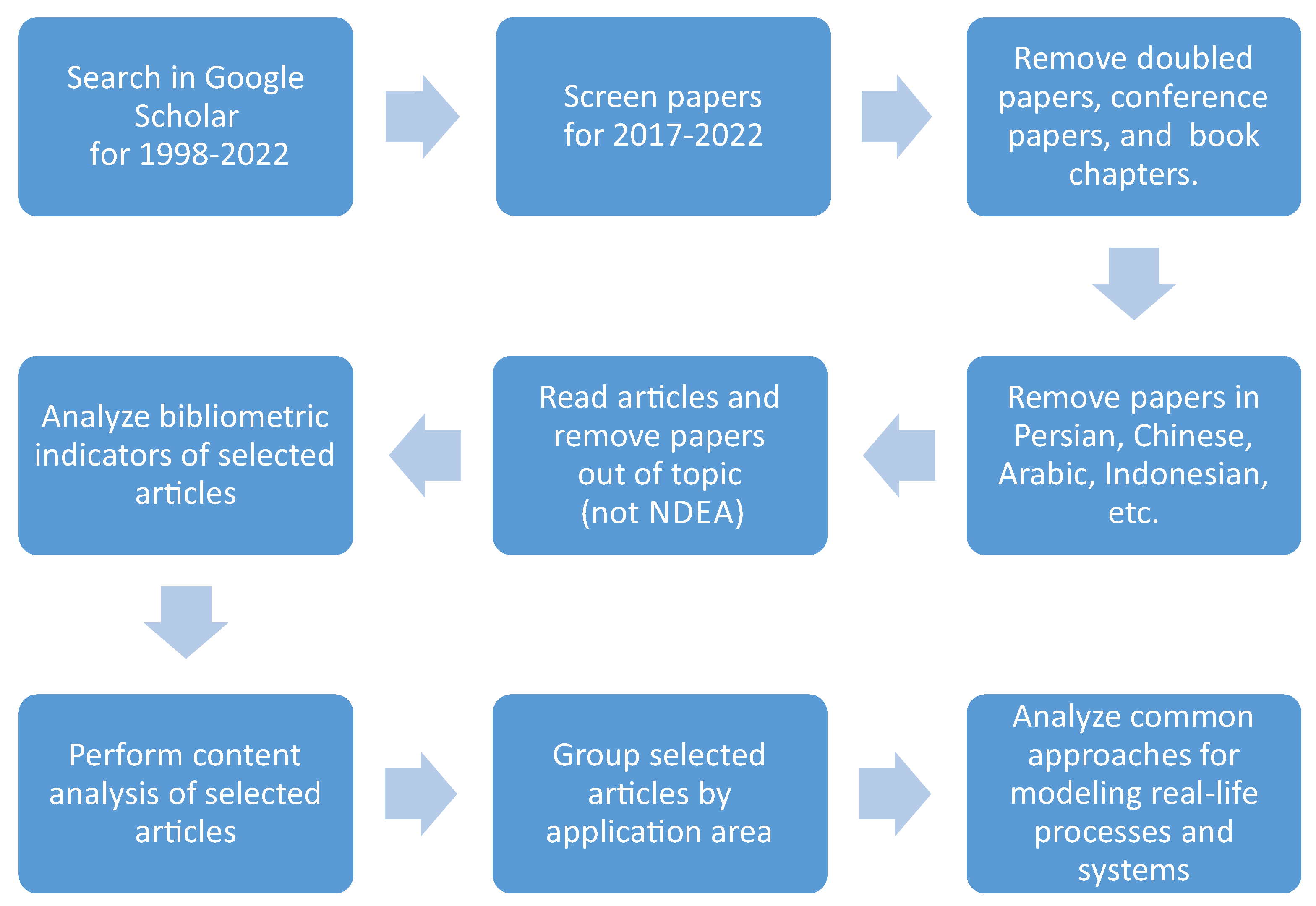
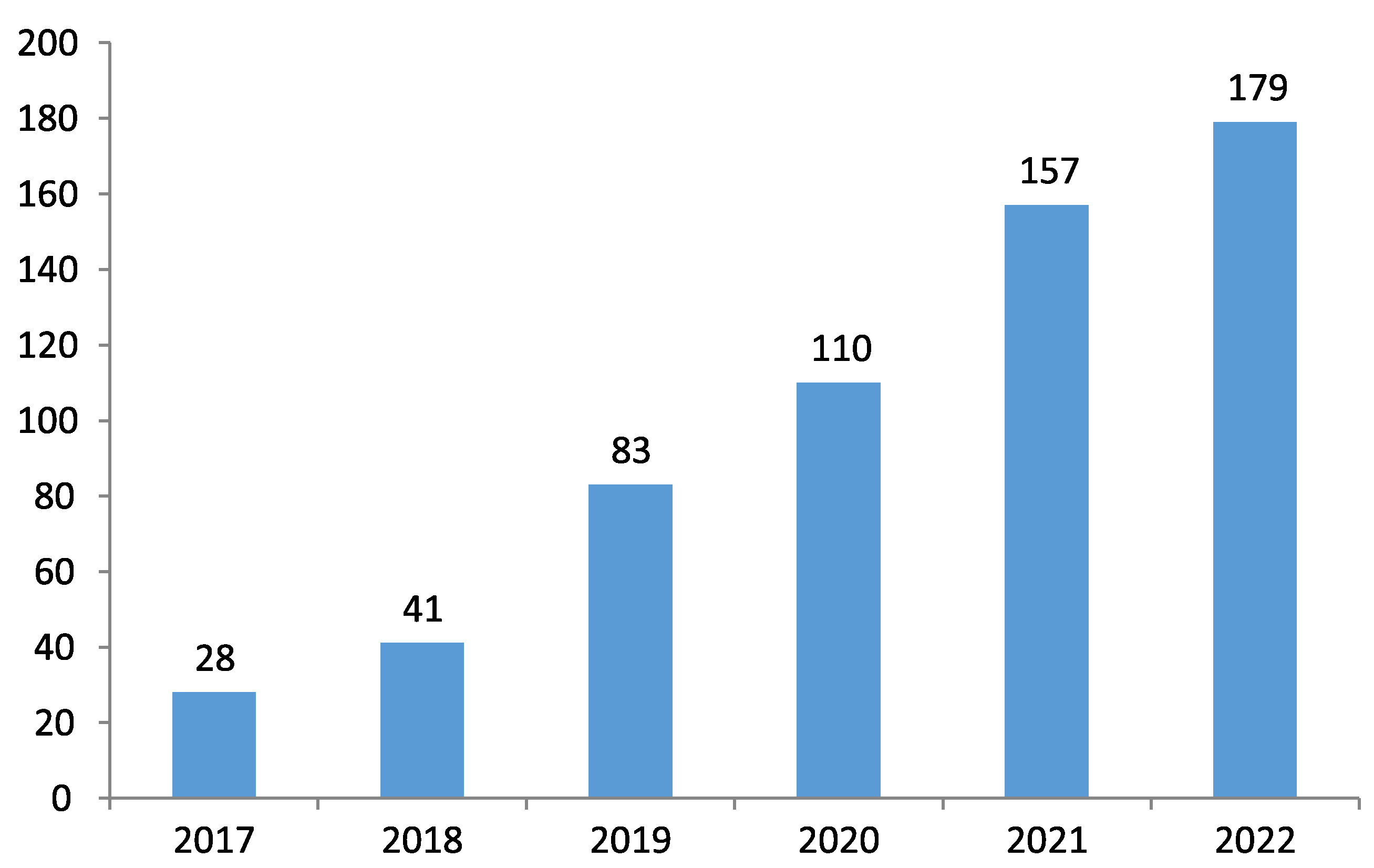
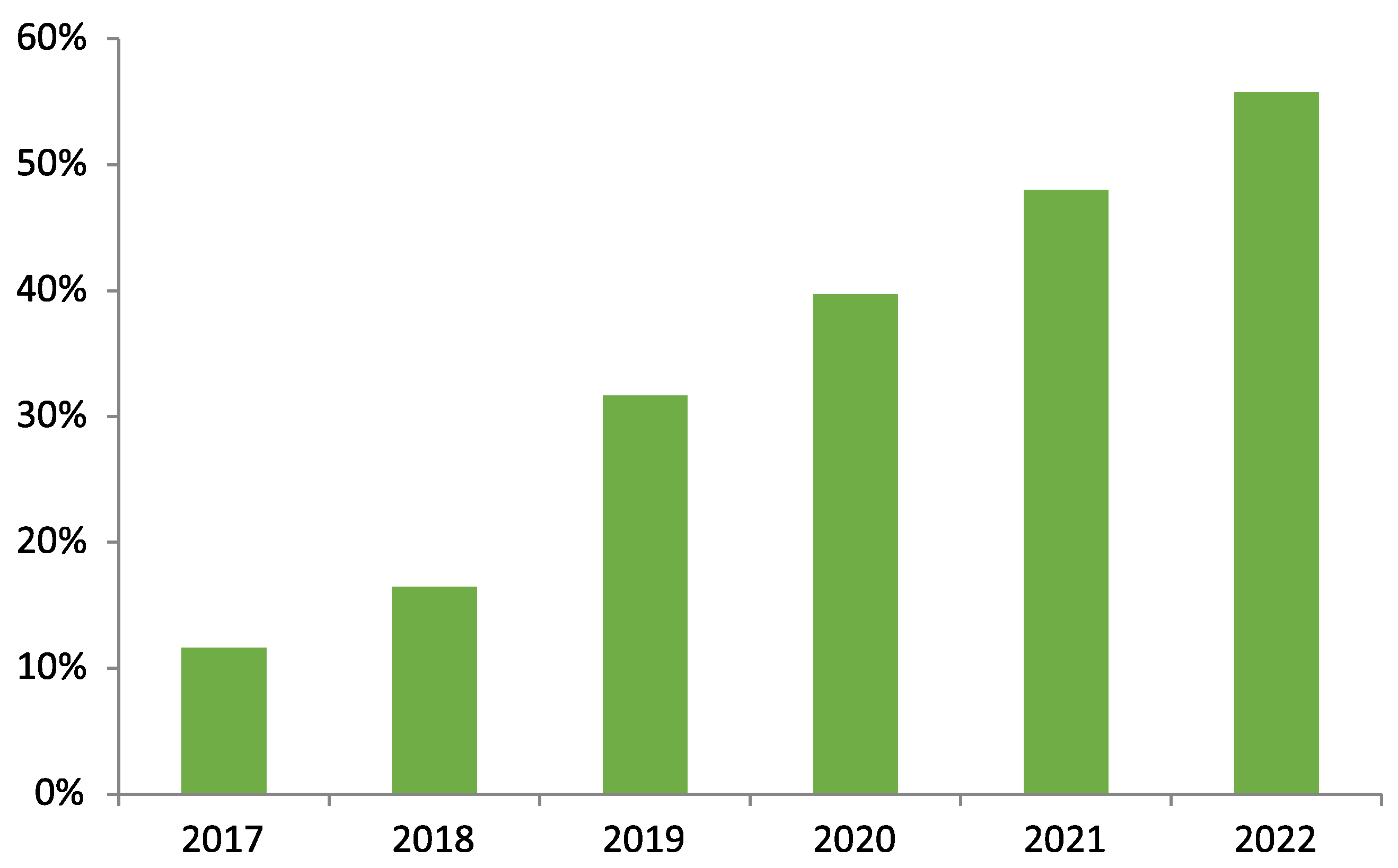
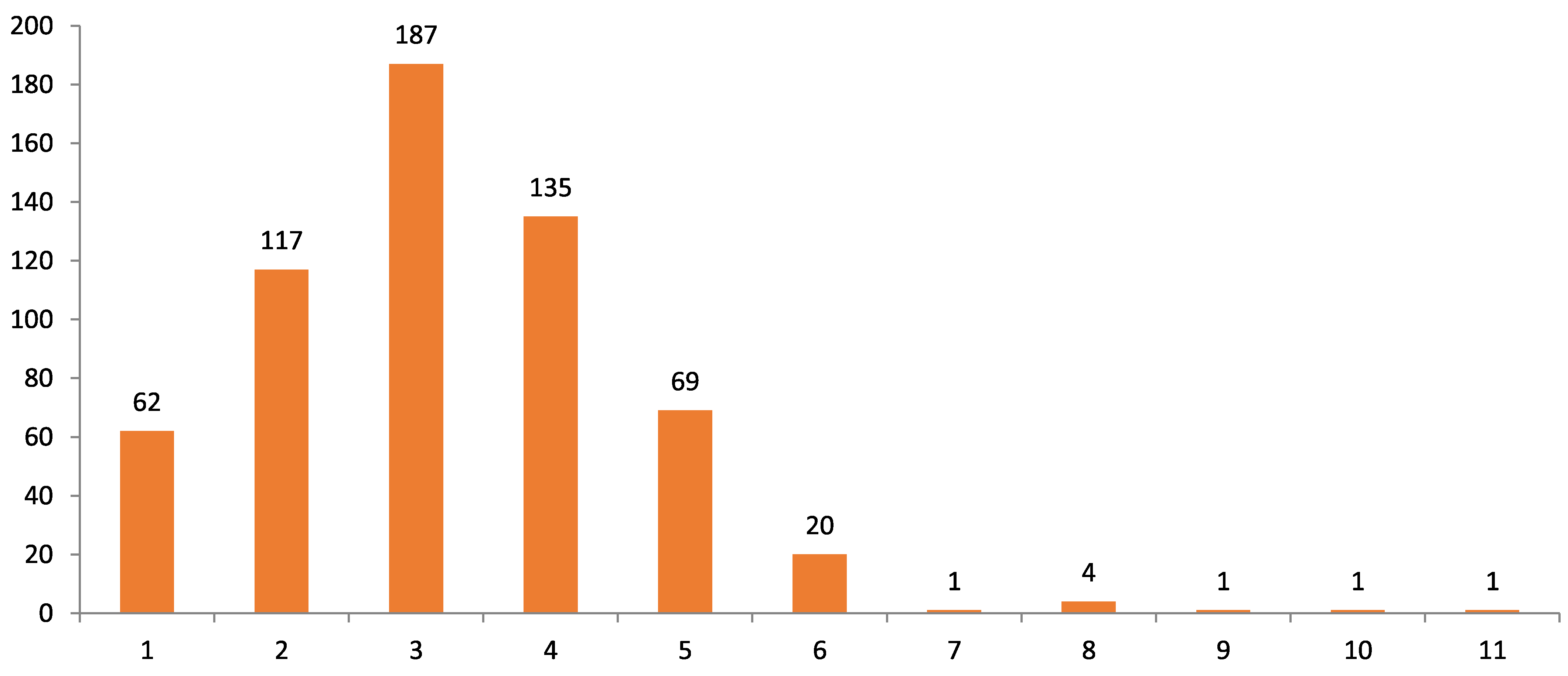
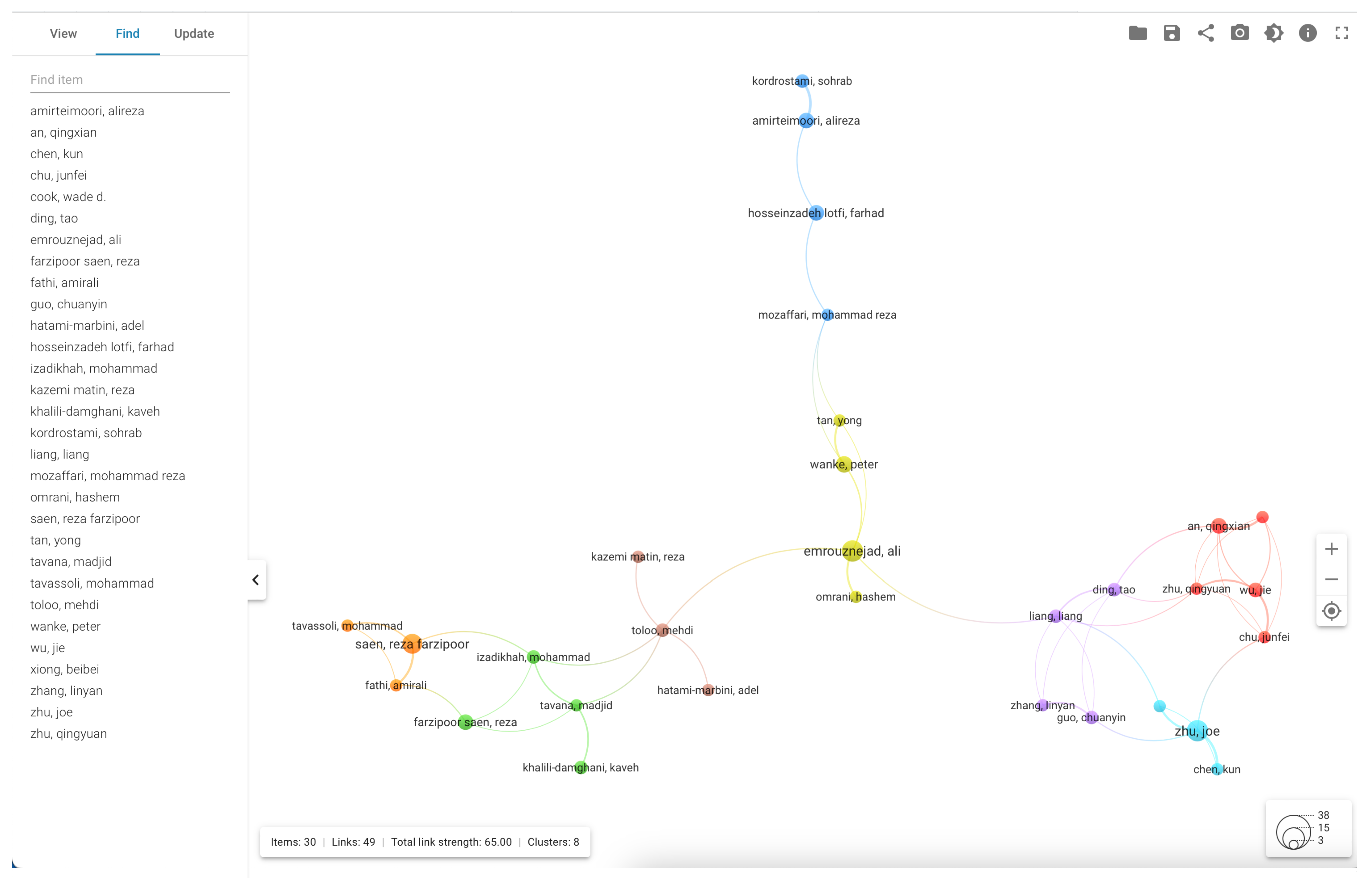

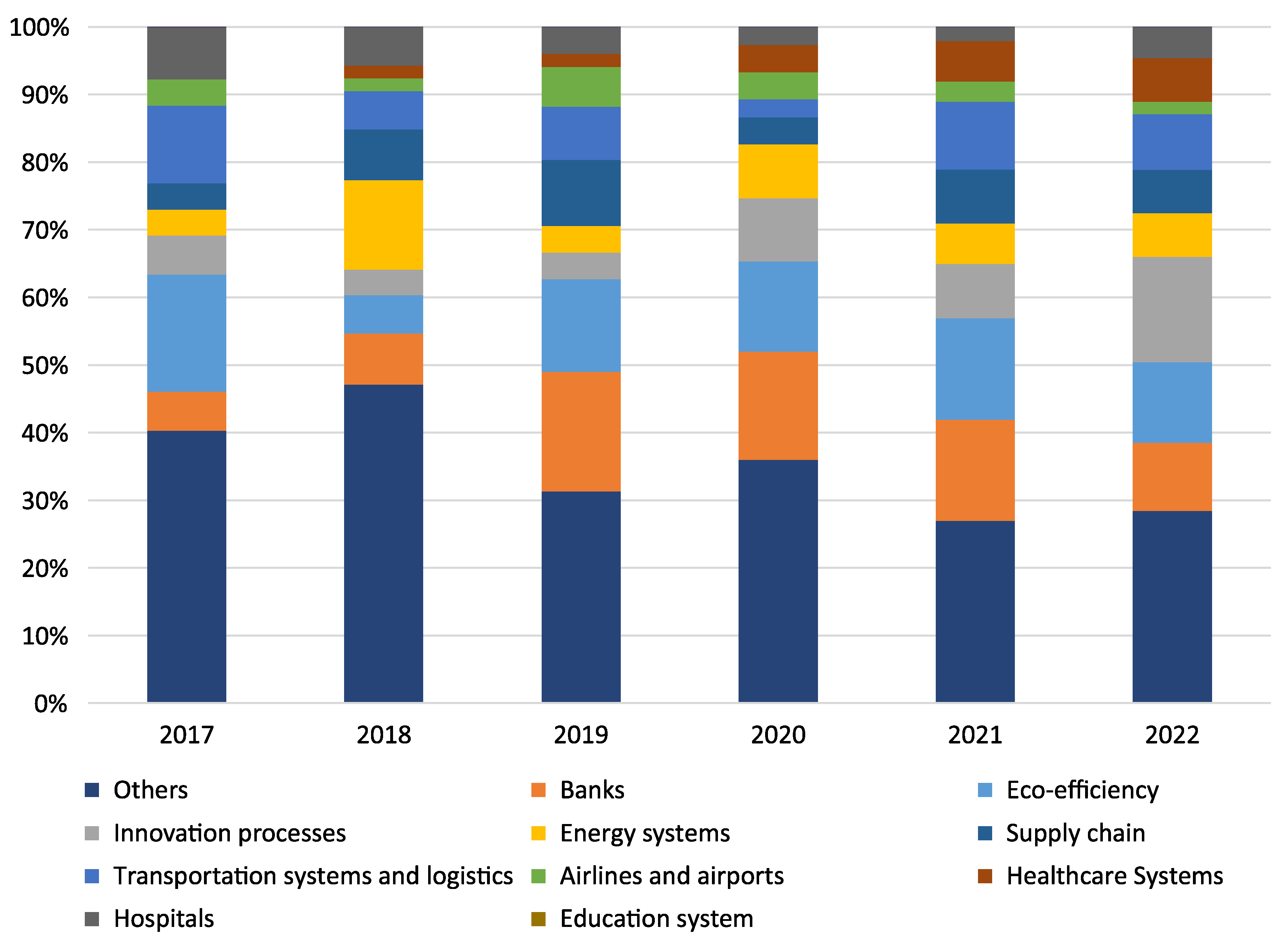
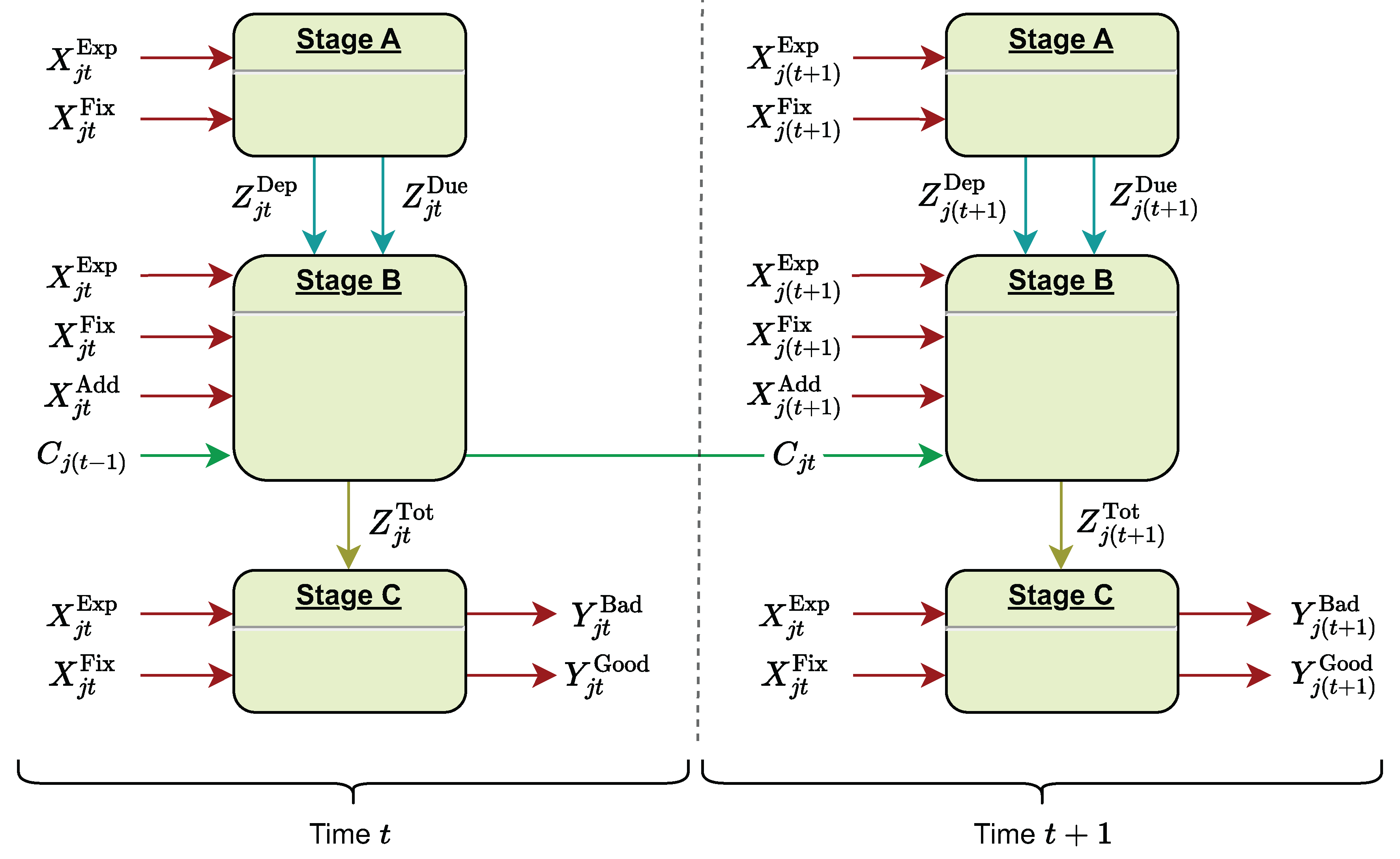
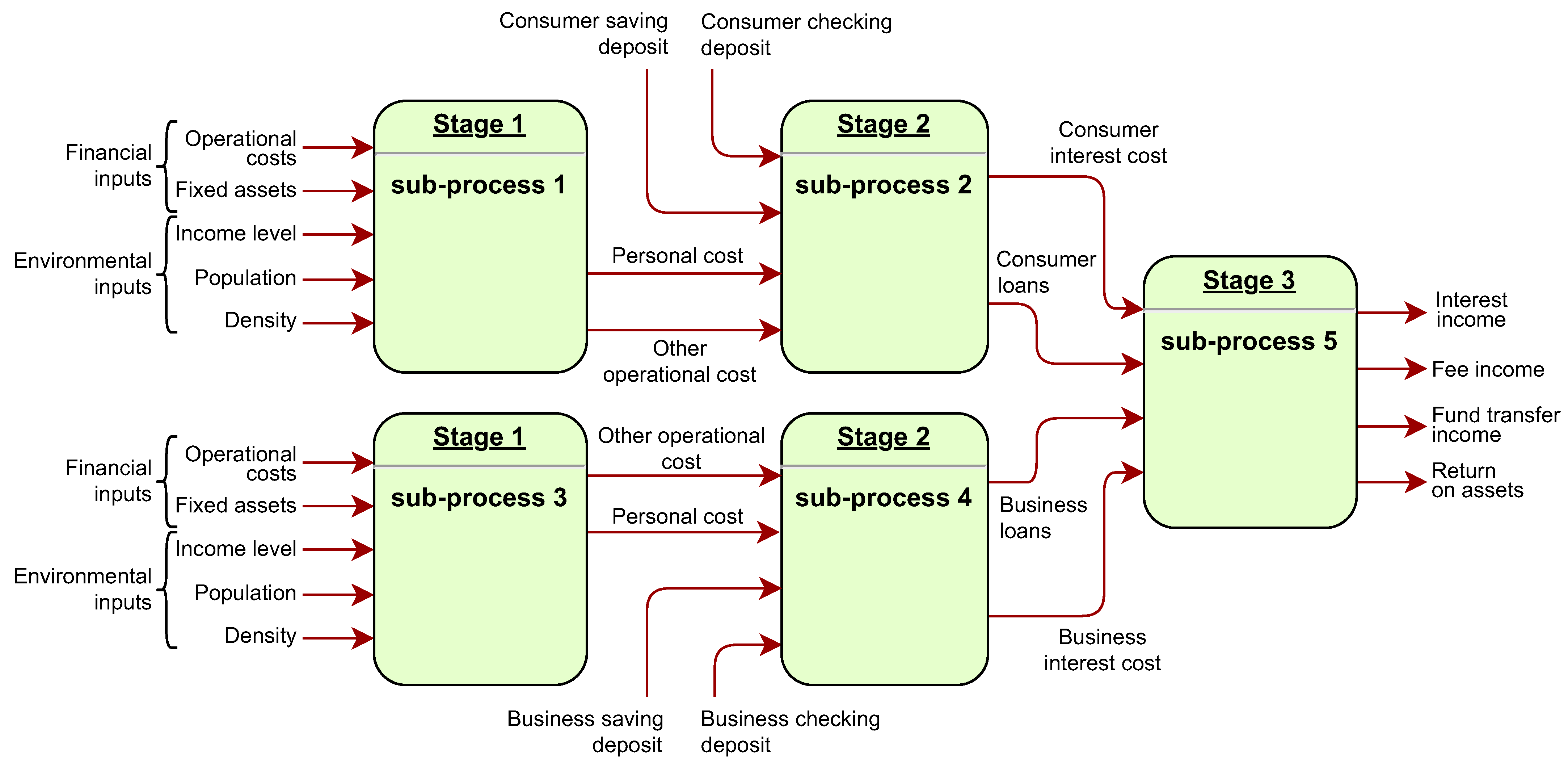

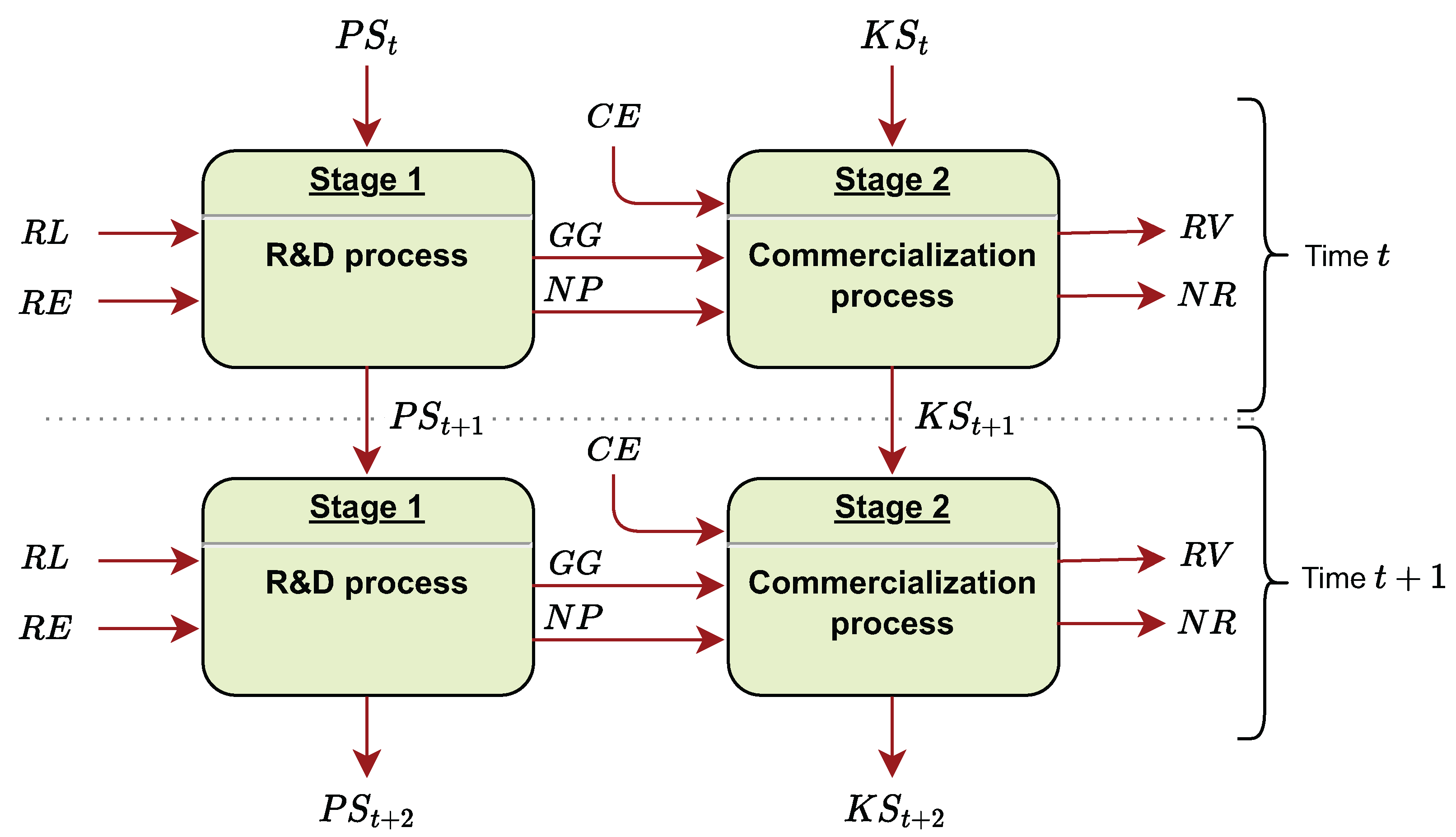
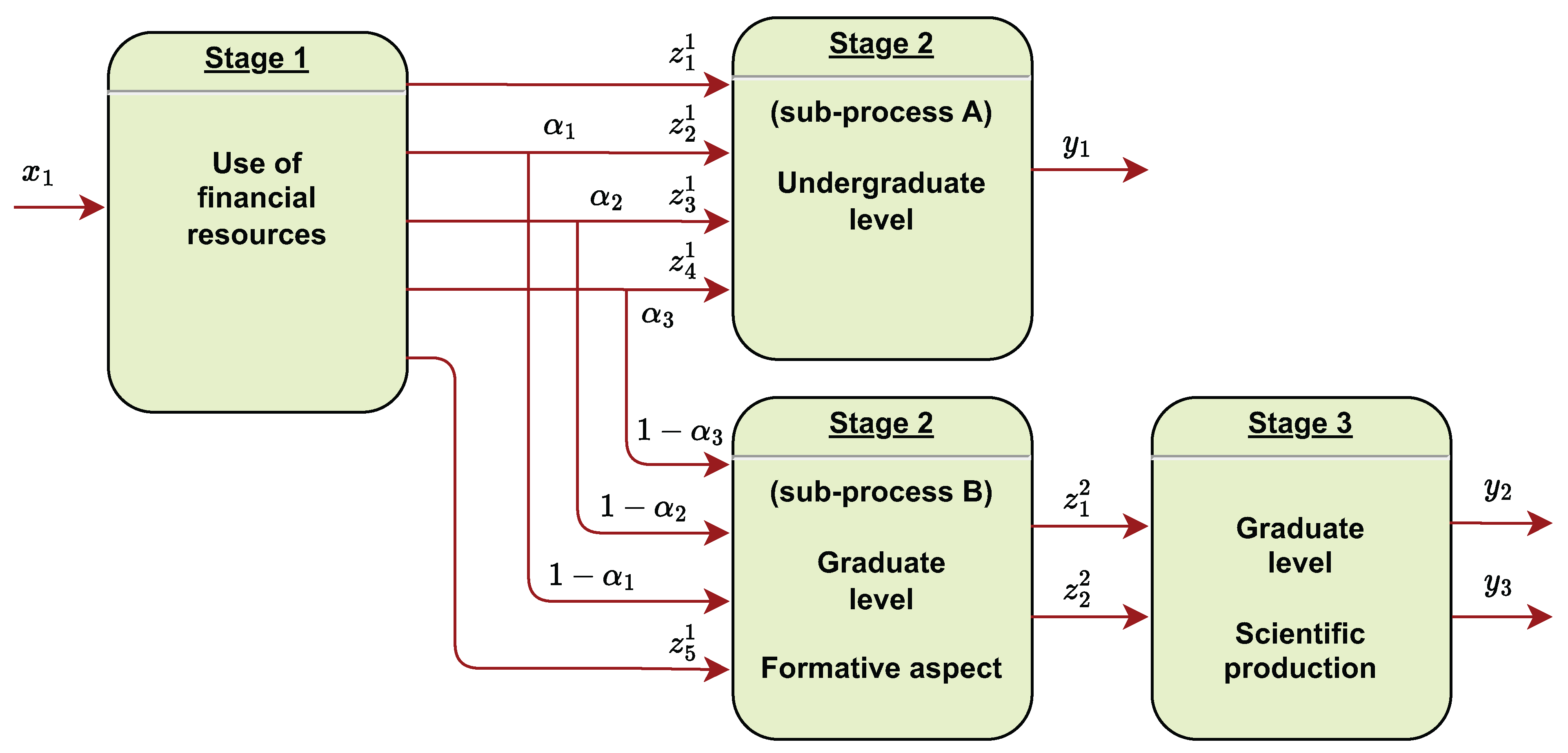
| No. | Journal | Articles | Percent |
|---|---|---|---|
| 1 | Sustainability | 29 | 4.85% |
| 2 | Annals of Operations Research | 19 | 3.18% |
| 3 | Journal of Cleaner Production | 19 | 3.18% |
| 4 | Omega | 18 | 3.01% |
| 5 | Socio-Economic Planning Sciences | 18 | 3.01% |
| 6 | Computers and Industrial Engineering | 17 | 2.84% |
| 7 | European Journal of Operational Research | 17 | 2.84% |
| 8 | Expert Systems with Applications | 16 | 2.68% |
| 9 | Journal of the Operational Research Society | 13 | 2.17% |
| 10 | International Journal of Environmental Research and Public Health | 11 | 1.84% |
| 11 | RAIRO—Operations Research | 10 | 1.67% |
| 12 | Energies | 9 | 1.51% |
| 13 | International Journal of Data Envelopment Analysis | 9 | 1.51% |
| 14 | Energy | 8 | 1.34% |
| 15 | International Journal of Industrial Mathematics | 7 | 1.17% |
| 16 | Operational Research | 6 | 1.00% |
| 17 | International Transactions in Operational Research | 6 | 1.00% |
| 18 | Mathematical Problems in Engineering | 6 | 1.00% |
| 19 | Central European Journal of Operations Research | 5 | 0.84% |
| 20 | Environmental Science and Pollution Research | 5 | 0.84% |
| 21 | PLoS ONE | 5 | 0.84% |
| 22 | Scientia Iranica | 5 | 0.84% |
| 23 | Journal of Intelligent and Fuzzy Systems | 5 | 0.84% |
| 24 | Advances in Mathematical Finance and Applications | 5 | 0.84% |
| 25 | Journal of mathematical extension | 5 | 0.84% |
| Total | 273 | 45.65% |
Disclaimer/Publisher’s Note: The statements, opinions and data contained in all publications are solely those of the individual author(s) and contributor(s) and not of MDPI and/or the editor(s). MDPI and/or the editor(s) disclaim responsibility for any injury to people or property resulting from any ideas, methods, instructions or products referred to in the content. |
© 2023 by the authors. Licensee MDPI, Basel, Switzerland. This article is an open access article distributed under the terms and conditions of the Creative Commons Attribution (CC BY) license (https://creativecommons.org/licenses/by/4.0/).
Share and Cite
Ratner, S.V.; Shaposhnikov, A.M.; Lychev, A.V. Network DEA and Its Applications (2017–2022): A Systematic Literature Review. Mathematics 2023, 11, 2141. https://doi.org/10.3390/math11092141
Ratner SV, Shaposhnikov AM, Lychev AV. Network DEA and Its Applications (2017–2022): A Systematic Literature Review. Mathematics. 2023; 11(9):2141. https://doi.org/10.3390/math11092141
Chicago/Turabian StyleRatner, Svetlana V., Artem M. Shaposhnikov, and Andrey V. Lychev. 2023. "Network DEA and Its Applications (2017–2022): A Systematic Literature Review" Mathematics 11, no. 9: 2141. https://doi.org/10.3390/math11092141
APA StyleRatner, S. V., Shaposhnikov, A. M., & Lychev, A. V. (2023). Network DEA and Its Applications (2017–2022): A Systematic Literature Review. Mathematics, 11(9), 2141. https://doi.org/10.3390/math11092141








